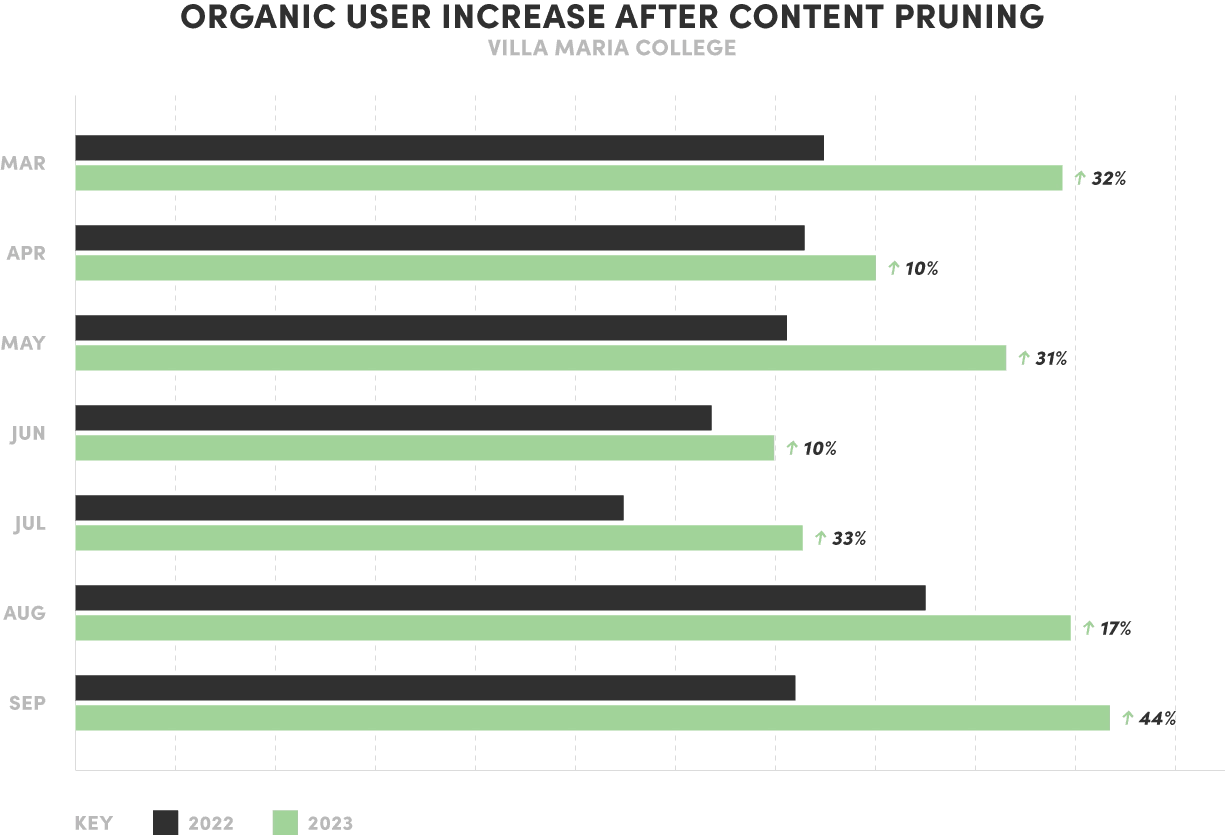If you have a blog on your website, you probably already know how beneficial it can be to your business. By writing and publishing quality content on a regular basis, blog posts can increase website traffic, improve visibility in search engines and establish your business as an authority on a subject.
So, the more content you add the better off your blog will be, right? Not quite. Believe it or not, it’s actually important to review, and potentially remove, your existing content through the content pruning process.
What Is Content Pruning?
Content pruning is a great way to take inventory of your online presence and optimize your content. The process involves removing outdated and low-performing content from your website and replacing it with new, more valuable content over time. Posts that have outdated information, haven’t received a lot (if any) traffic, or contain minimal or duplicate content should either be removed and redirected to more relevant posts or updated with new information that better reflects the topic in question. It’s important to take time once or twice a year to perform a content audit to identify content that’s ready to be pruned.
Why Should You Prune Content?
Content pruning is a lot like cleaning out your closet. If you never discarded pieces of your wardrobe, your closet would become so cluttered you probably wouldn’t be able to keep track of what fits and what’s still in style. Without looking at your blog as a whole every once in a while, you won’t really know what’s living 10 or 20 pages back in the archive. Ok, but why does this really matter for your website?
Optimizing for EEAT
Search engines like Google routinely update algorithms to reward high-quality content from good sources of information. Google Now considers a website’s quality as a whole when ranking individual pages in SERPs based on its Quality Raters’ Guidelines. EEAT (experience, expertise, authoritativeness and trustworthiness) is a major factor in these guidelines. Every piece of content you write and publish should be created with these factors in mind. Pruning posts that lack personal experience, first-hand knowledge, credible sources and factual information should be removed to improve your website’s quality as a whole.
Crawl Budget and Indexing
Crawl budget is the number of pages on your website that search engines like Google will sift through and index within a certain timeframe. By indexing, we mean when Google stores content so it can be retrieved quickly for users searching for relevant terms and information. So, if a site’s content exceeds its crawl budget, some pages might not get indexed until the next time the search engine crawls the site. That could delay how long it takes for your higher-quality posts to found in search results.
When Should You Content Prune?
Unsure whether your website needs to be pruned? Ask yourself these questions.
Have You Recently Redesigned?
If the answer is yes, you probably only need some tweaks here and there, like removing outdated content. Since a redesign is an overhaul, you’ve already made a lot of significant changes to your website. If you haven’t redesigned in a while, it may be well worth your while to conduct the content pruning process.
Are Your Offerings Still Available?
Some businesses go months or even years without realizing some website content includes products or services they no longer offer. It’s hard to stay on top of your older content all the time, but you should make it a priority to review at least on an annual basis.
Is Your Content Outdated?
The material on your website needs to be up to date with industry trends and standards in addition to your business offerings. By nature, trends change; keeping up with them is a job all its own. Compare your content to your competitors’ to help you decide what should stay and what can go.
Have You Created Better Content?
The content you posted months or years ago may not reflect what you know now. As your business and team grow, so does your understanding of the industry and your target market. This is likely reflected on your digital platforms. Content pruning allows you to make adjustments to show your audience how far your business has come.
Which Posts Should I Remove?
Effective content pruning starts with a content audit. Head over to your website’s Google Analytics accounts. We compile a list of every blog post currently published on the website and use Google Analytics to see how many views each post had along with other metrics like engagement rate and conversion rate. From there, we identify URLs that have subpar performance. Just be sure to double-check publishing dates on your content; some new pieces of content might not have had enough time to perform yet. Next, we comb through the information presented on lower-performing URLs from our list. Usually, the content on these posts is outdated, thin (or even duplicate) or irrelevant to the website’s primary purpose.
Reviewing Google Analytics and the results of a content audit will give you a better understanding of what your readers are most interested in. With both high- and low-quality posts identified, you can decide what to do with the posts that no longer serve a purpose. You can either remove these posts by deleting them and redirecting their URLs, updating the content so that it better reflects your business and your readers’ interests, or removing them from Google’s index with a no index directive. While removing a bunch of posts that don’t get a lot of attention might be tempting, you should avoid over-pruning. This can really affect your website’s organic traffic, so we recommend updating and combining posts with potential if possible and only discarding those that are truly unhelpful.
Putting Content Pruning into Practice
It’s pretty much impossible to isolate the benefits of content pruning. It usually happens simultaneously with other content updates and even technical optimizations. However, we’ve seen sustained growth in user and traffic acquisition after cutting out of date, low-quality posts too many times for it to be a coincidence.

Take Villa Maria College. As part of our holistic SEO strategy, we conducted a content audit and got busy content pruning their website earlier this year. Beyond the many pages of content related to academics, admissions, sports, students and more, Villa has a news section comprised of press releases and blog posts. Some of these posts date back to 2011, so it was time for a “spring cleaning.” We came up with over 80 posts that we could redirect and remove or combine and update with more relevant content. Those efforts helped Villa gain a 22% increase in organic users year over year.
